At least a quarter of all appliance repair calls are resolved with no-brainer solutions like pushing a button or flipping a circuit breaker. The team at Family Handyman shares what to look for and how to avoid these expensive lessons.
Garbage Disposal
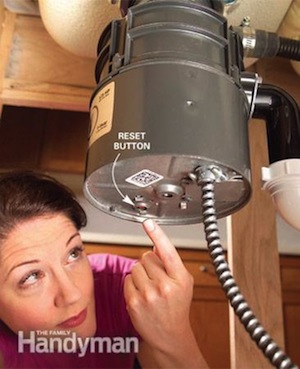
All disposals have an overload feature that automatically shuts off the power when the motor becomes overloaded and gets too hot. Once the motor cools, simply push the reset button on the side of or under the unit.
On the other hand, if it hums but doesn’t spin, it may have something stuck in it. Switch the disposal off, then try working through it by turning the blades with a special disposal spanner (sold at hardware stores) or by turning a bottom bolt. Many disposals have an Allen key for that purpose, inset on the bottom of the machine.
Lights
When a light goes out or a switch doesn’t work, you should first check the main electrical panel for a tripped circuit breaker. But don’t stop there. Before you change out light bulbs and switches, see if a GFCI outlet (which may be upstream from the troubled light or outlet) has tripped. Sometimes all the bathrooms or the outside lights are powered through a single GFCI located in one bathroom or elsewhere, such as in a basement. Simply push the reset button on the GFCI and you could be back in business.
Refrigerator
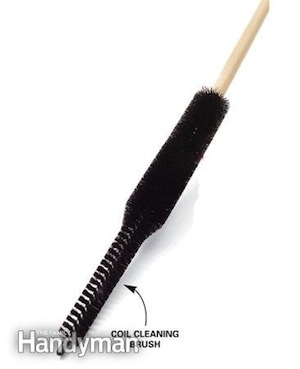
If your refrigerator conks out on a hot day and you have a cat or a dog, immediately check the coils for pet hair. Service pros find this problem on half of their refrigerator calls. The coils are the black tube-and-wire grid that cools the fluid in the compressor. A buildup of hair will cause the compressor to overheat and trigger the overload switch. On many fridges, you get to the coils by opening the grille at the bottom of the refrigerator. Then push a coil cleaning brush (sold at home centres) into the coils, pull it back and vacuum it clean.
If the coils are located on the back, pull out your fridge (it’s often on rollers) and brush them off. Bonus: The clean coils will cool more efficiently and save you money on your utility bill! Once the overload switch is tripped, you may have to wait a few hours for it to cool. It will reset itself and turn the refrigerator back on.
Gas Stove
If your stove burner won’t come on, the likely culprit is the spaghetti sauce that boiled over a few days ago. Use a toothbrush to clean off food spills from the igniter. On an electronic ignition stove, it’s a little ceramic nub located either on the stovetop or under the ceramic seal strike plate. Also make sure that the round ceramic seal strike plate is properly seated on the burner.
Electric Range
If your electric stove burner won’t heat, turn the burner off and pull it out from its socket. Then plug it in again and wiggle it around. If it feels loose, remove the burner again and gently bend the burner prongs slightly outward for a tighter connection. Easy does it. You could end up pushing the whole socket out of its bracket.
Standing Gas Pilot Range
To access the ignition system in an older-style standard gas range, pop the lid. It’s usually hinged on the back side. If the pilot flame is out, poke a needle into the pilot hole to clean out soot (be careful not to ream it wider). Brush off any debris and clean the tube that leads from the pilot to the burner. Then relight the pilot.
Oven Controls
Blame it on the technology. It so happens that if you set the “time cook” function, the oven, much like a programmed VCR, won’t turn on until the appointed time. You may have done this inadvertently, but if your digital display reads “hold”, “delay” or “time cook”, then the timer is engaged. You’ll have to clear it first by pushing the “off” button. On ovens with dials, be sure the knob is turned to “manual”.
Washing Machine
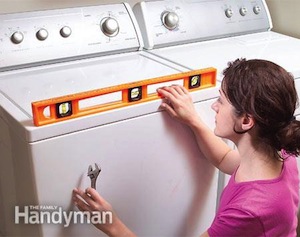
When a washing machine cabinet rocks, it makes a horrible racket during the spin cycle. The solution is to simply readjust the legs. Screw the front legs up or down until the cabinet is level. When both legs are solid on the floor, tighten each leg’s locking nut. In most washers, to adjust the rear legs, gently tilt the machine forward and gently lower it down. The movement will self-adjust the rear legs.
Dryer
Our expert repairman responds to many “dryer-not-heating calls” only to find that the machine is set to “fluff air” — a non-heat setting. Avoid the embarrassment. Check the settings first. Another common cause of poor drying is a clogged lint filter. The filter may look clean, but it may actually be covered by a nearly invisible film caused by dryer sheets. This film reduces airflow and forces the thermostat to shut off the heat before your clothes are dry. Test your filter by pouring water into it. If the filter holds water, it’s past time to clean it. Pull out the filter and scrub it in hot water with a little laundry detergent and a stiff kitchen brush.
Also check the outside dryer vent for any lint that may have built up there. The louver door — style vent covers are notorious for lint buildup, which traps heat and turns the heat off in the dryer. Pull the cover completely off to get to these clogs.
Air Conditioner
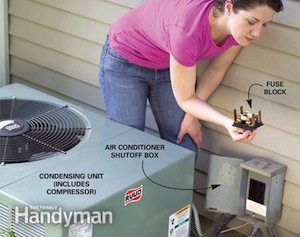
If you turn your central air conditioner on, off and then on again in rapid order, chances are you’ll blow a fuse or shut off a circuit breaker, or the air conditioner simply won’t respond. That’s because the compressor (in the outdoor condensing unit) may have stopped in a high compression mode, making it difficult to start until the compression releases. Older condensing units may switch the compressor on anyway, which causes the circuit to overload and blow a fuse. Newer, “smarter” condensing units will prevent this blunder by delaying the AC’s “on” function for a few minutes. It’s easy to mistake this delay with a faulty air conditioner. Be patient and give the air conditioner about five minutes to come back on.
To determine if you have a blown fuse, locate the special fuse block near the outside unit. Pull out the block and take the whole thing to the hardware store. A salesperson can test the cartridge fuses and tell you if you need to replace them.
Another simple reason your AC might not come on: You’ve signed up for a cost discount with your electric company in exchange for limited air conditioning during high-demand periods, and you’re in an “off” period. If you can’t remember, call your electric company to find out. You don’t want to pay the repair technician to drive out and explain this program to you!
Dishwasher

When your dishwasher no longer gets your dishes clean, a food-filled filter is most often to blame. If it’s clogged, water can’t make it to the spray arms to clean the dishes in the top rack. The fix takes two minutes. Simply pull out the lower rack and remove the filter cover inside the dishwasher. (Check your owner’s manual if you can’t spot the filter.) Then use a wet vacuum to clean off the screen.
While you’re there, slide the nearby float switch up and down. If it’s jammed with food, you won’t get any water. If the cover sticks, jiggle it up and down and clean it with water. [clear]
Simple Fixes for Common Appliance Problems [The Family Handyman]
The Family Handyman is the DIYers best friend, offering a variety of print and digital resources for do-it-yourself homeowners. Their forte is accurate and complete how-to instructions for improving homes, yards and vehicles.
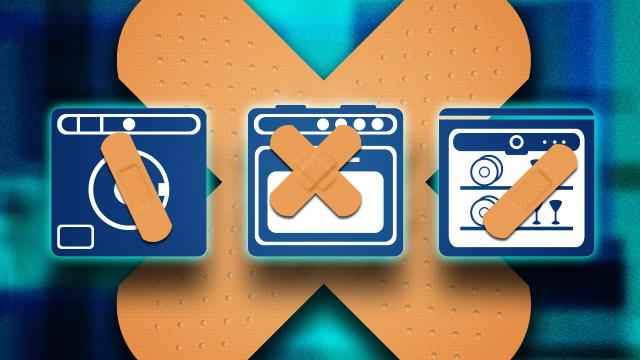
Comments
20 responses to “How To Fix 11 Of The Most Common Household Appliance Problems”
Anything electrical occasionally blow out with an air compressor.( within reason)
I’d be careful using a compressor on electrical equipment given they do condense water in the air tanks.
Good tip,hadn’t thought of that
This has to be one of the stupidest lists that I’ve seen on here – If people don’t know how to pull it apart on their own and successfully effect a repair then they shouldn’t touch it. Half of these faults are symptoms of a real problem (wriggle the socket? really? why don’t I just short these 2 frayed wires together – nothing bad could possibly happen)
Yes, wiggle the socket. And bend them back until it’s firmer. Much better than paying $100’s to someone who’ll do the same thing. There’s no point replacing something if it’s only bent, but otherwise in good shape.
Also… dryer sheets? In-sink garbage-disposal units?
That’s sounding awfully American.
garbage disposals should be more common over here, they are awesome.
I only just realised my garbage disposal had this problem, it’s been out of action for the last 3-4 weeks! Without it dishes are so much more annoying!
I don’t know about dryer sheets but it’s not unusual for Aussie houses to have in-sink garbage disposal units. It’s possible that you only get them by the norm with newer houses though.
I wonder who has a wet vacuum just lying around?
I do. Had a Vax for years, not the best vacuums in the world but the wet and dry combo is really handy.
Do we even have garbage disposal units in Australia? I’ve certainly never been to a house that’s had one.
Most peoples homes I’ve been to have them. About 80%
It would not be 80%. My apartment is the first house I have been in that has a garbage disposal unit. I’d say closer to 30-40%.
Seconding
This is a classic LH argument.
“I’ve never seen one, therefore nobody has one”
“No, everyone I know has one therefore everybody has one”
Where have you been? We had one in our house when I was a kid, some 30 years ago…
Garbage Disposals waste electricity and water. Just compost the stuff, stop sending to the sewerage works to only end up as toxic blooms in the sea.
Right on mate!
GFCI? i had to look it up. It’s american for RCD 🙂